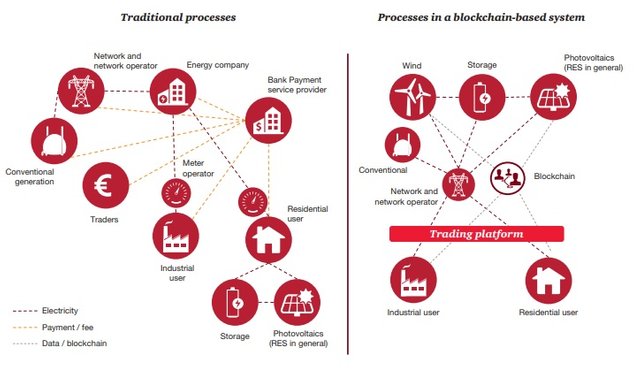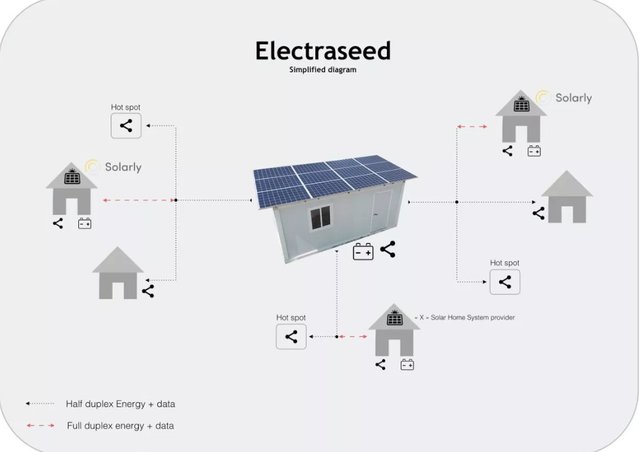Solar Energy Commentaries #2: Solar Blockchains, ElectraSeed, Plus Other News and Planned Articles
As we go into August 2018 I'd thought I would spend this second short article synchronizing the commentaries to both the beginning and middle of the month, and of course share a little more details regarding current developments in the solar energy market.
So first off let us discuss the subject of energy blockchains. For starters, it has been recently proposed over the past few years (shortly after the invention of Bitcoin and the underlying infrastructure as a matter of fact!) to use blockchain technology in order help restructure the electrical power grid to better accommodate renewable energy production, and provide a new platform with which to trade energy in an peer-to-peer setting. One primary benefit of using blockchains is that there is no need to reinvent the wheel when it comes to trading and distributing energy, as the same principles for trading cryptocurrences can also apply to the electricity. This is a very active area of research as of late, and as a matter of fact it is something with which I am directly involved in on some level for my own dissertation. More details will of course follow as time goes on!
A good summary of the key concepts involved in merging blockchain with the electrical grid can be found in this article here (make sure your Adobe PDF reader is up to date!): https://www.pwc.com/gx/en/industries/assets/pwc-blockchain-opportunity-for-energy-producers-and-consumers.pdf
As can be seen in the diagram below (PwC 2016, pp. 18), the blockchain allows for a more simplified and direct transmission system for electricity distribution, cutting out the third party altogether in the trading process and thus making the implementation of microgrids much easier. Another main benefit could also be the streamlining of demand side management as electricity demand can be closely monitored and logged on a real-time basis (blockchains could be integrated on smart meters, for instance).

Figure 1. Transformation of market structures on introduction of decentralised transaction model, figure reproduced from PwC (2016, pp. 18).
There are a couple of noteworthy case studies worth looking at, both here in the UK and also in Africa. Within the UK in particular the first ever energy blockchain trade took place in April 2018: https://cleantechnica.com/2018/04/28/solar-power-trade-using-blockchain-completed-in-uk/
In particular a solar energy start-up known as Verv successfully distributed around 1 kWh of solar energy to a local neighborhood district within London, thus proving its viability as a method of energy trading for renewable resources (Clean Technica 2018).
It also holds promise in developing nations such as many of those located within Africa, where many areas often lack the infrastructure needed to properly deliver electricity in the first place. One such project that is starting up is ElectraSeed, wit h the end goal of building a series of microgrids and related infrastructurein order to provide over 12 million people with electricity: http://www.electricchain.org/our-projects/project-13/
Each ElectraSeed is an integrated solar PV production and energy storage installation as seen in Figure 2 below and basically akin to a miniature solar power plant (ElectriCChain 2018). It is hoped that by the end of 2019 there will be over 100 units deployed (ElectriCChain 2018). The unit of currency used for energy transfers between each of the units is the SolarCoin, which is an internationally accepted currency for the solar energy market (ElectriCChain 2018).

Figure 2. Simplified Diagram of an ElectraSeed unit, figure reproduced from ElectriCChain (2018).
All very exciting stuff indeed, and I am firm believer of this approach. One of the main issues with renewable energy deployment has always been the fact that it solar (along with wind, tidal and wave energy) are as a general rule a non-dispatchable source of electricity. This is because 1) they are intermittent and 2) there is a mismatch between most consumer load profiles and the best times for when the energy can be produced (e.g. in the case of solar, most of the energy can be produced mid day, but most of the residential demand is usually in the evening). Peer-to-peer trading of this kind may have the potential to help shift load profiles, as well as more easily integrate electricity storage into the overall grid.
For Next Time:
Moving on from blockchains, it is perhaps time to quickly elaborate the format of some of my future articles for Steemit. The commentaries as stated before are going to be on a biweekly basis. But they aren't the only articles that I will write in the coming days. Also in the pipeline (and the subject of my next article) are going to be a series of short essays which discuss the overall historical perspective of energy production and distribution, from the Neolithic Age all the way to the Information Age and beyond. Another series currently in the pipeline is the geopolitics of energy, particularly with regards to the transition from fossil fuels to renewable energy.
And with that, the next solar energy commentary will be published on August 15th, stay tuned!
=============================================================================================
References:
-ElectriCChain. 2018. ElectraSeed Multi-GW Micro-Grid Project – Ongoing. Available at: http://www.electricchain.org/our-projects/project-13/ [Accessed 31 July 2018].
-PwC. 2016. Blockchain – an opportunity for energy producers and consumers? Available at: https://www.pwc.com/gx/en/industries/assets/pwc-blockchain-opportunity-for-energy-producers-and-consumers.pdf [Accessed 31 July 2018].
-Richardson, J. 2018. Solar Power Trade Using Blockchain Completed In UK. Available at: https://cleantechnica.com/2018/04/28/solar-power-trade-using-blockchain-completed-in-uk/ [Accessed 31 July 2018].
Congratulations @xelloss! You received a personal award!
You can view your badges on your Steem Board and compare to others on the Steem Ranking
Vote for @Steemitboard as a witness to get one more award and increased upvotes!